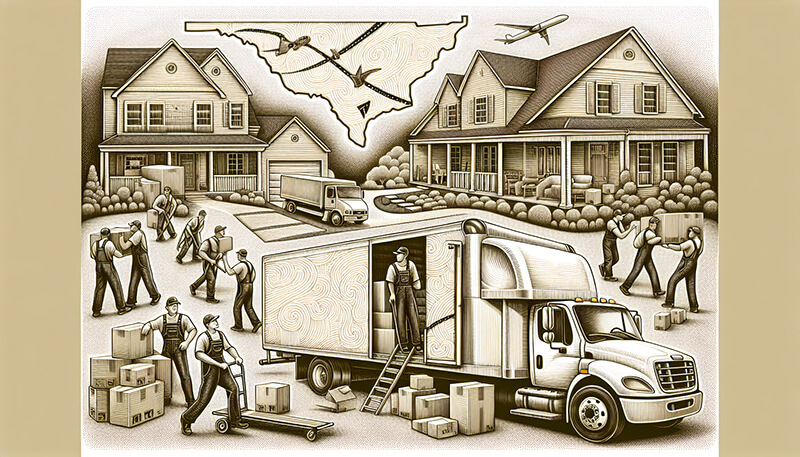- About
- Moving Services
- Antiques
- Art & Uniques
- Cross Country Moves
- Estate Moves
- Full Service Moves
- Long Distance Moves
- Los Angeles Moves
- Moves Within California
- Packing Crating Services
- Pianos
- Residential Moves
- Small Moves
- West Coast Moves
- Storage
- Freight / Shipping
- Tips & Tools
- Blog
- FAQ
- Movers Glossary
- Moving Brochure
- Moving Checklist
- Moving Tips
- Rights and Responsibilities
- Ready to Move Brochure
- Reviews
- Discounts
- Get Quote
- Now Hiring
- Contact
- Accessibility

We have earned the service industry’s coveted Angie’s List Super Service Award, reflecting an exemplary year of service provided to members of the local services marketplace and consumer review site in 2016.
Understanding Moving Costs

Before exploring strategies for a cost-efficient relocation, it is critical to thoroughly understand the various expenses associated with moving. The total cost of your move can fluctuate significantly based on factors such as how far you’re going, the number of items you need transported, and the degree of service you select.
Using a moving container company can be a cost-effective option for short-distance moves, as it often provides a budget-friendly alternative to traditional moving services.
For instance, an average local move within 50 miles might set you back about $1,250. In contrast, should you undertake a long-distance move covering approximately 1,000 miles for an ordinary home containing two to three bedrooms, the expenditures could climb close to $4,890. Getting familiar with these standard costs provides a robust starting point when planning your moving budget and helps in creating realistic financial expectations.
Common Expenses
In planning your move, it’s crucial to consider the various typical costs that can quickly add up. These expenses often encompass:
- The cost associated with hiring professional movers or securing a rental moving truck
- Acquiring necessary packing supplies such as boxes and adhesive tape
- Potentially incurring charges for temporary storage solutions, including renting a storage unit for flexibility in the moving process
- Easy-to-miss essentials like dollies, protective moving blankets, and ratchet straps are vital for ensuring the move goes smoothly.
For those choosing to rent a vehicle for their relocation needs, be ready to spend from $50 on a local move to $2,000 when tackling long-distance hauls. Anticipating these outlays helps you craft an exhaustive budget plan for your moving process and avoid unexpected financial burdens.
Hidden Fees to Watch Out For
While most reputable moving companies strive for clear billing, it’s critical to be vigilant for any hidden fees that could inflate your overall moving expenses. Hidden costs may include:
- Fees for canceling or changing the date of your move
- Additional insurance coverage charges for items of high value
- Charges incurred when a moving truck is unable to park near your home
Some companies might also charge extra fees for premium services like specialized packing, taking apart and putting together furniture, or handling unique items such as pianos or antiques. To avoid unexpected hits to your budget, ask for an exhaustive list of all potential fees before you finalize your estimate with the movers. Putting in this effort upfront to fully comprehend every detail can end up saving substantial amounts of money down the line.
How to Create a Moving Budget
Establishing a detailed moving budget is essential to prevent any unnecessary financial strain. To craft this budget effectively, consider the following steps:
- Determine the typical cost for movers in your vicinity which will serve as a benchmark when you start negotiating prices.
- Compile all possible costs, from packing materials to transportation expenses, and ensure that you account for unforeseen charges by adding extra cushioning to your estimates.
- If feasible, plan on covering relocation costs with cash, thus avoiding additional charges that accrue through credit card interest.
Before you opt-in for supplementary insurance provided by your moving company, review what may already be covered under existing home or auto policies. Coverage could extend over possessions during transit. By adhering strictly to an itemized budget, you’ll facilitate smarter choices during your move and keep control over how much you spend within the constraints of said budget.
Cheapest Ways to Move Without Sacrificing Quality

In the pursuit of relocating within your budget constraints, it’s essential to balance cost-effectiveness with reliable service. There are a multitude of economical choices available that ensure both the security of your possessions and mental tranquility—from self-conducted relocations and combined approaches to reasonably priced professional movers, we will explore various methods for affordable moves without sacrificing quality.
In some situations, hiring movers makes sense, such as when moving heavy items, dealing with physical limitations, or managing the complexity of the move.
It’s crucial to choose a moving method that corresponds with your financial plan and fits within your schedule and skill set. Occasionally, what appears cheapest at first glance may not be the most cost-effective solution over time.
DIY Moves
If you’re operating on a tight budget but have the determination to take matters into your own hands, opting for a DIY move can be an effective way to cut costs. By taking charge of securing a moving truck and managing every step from packing to loading and then unloading, you’ll certainly keep expenses low. It’s important to acknowledge that this is the most labor-intensive option requiring significant personal involvement. The benefit is having full authority over each aspect of the move and setting your timetable.
To bolster the success rate of your self-guided relocation endeavor without busting your budget, consider rallying support from friends or family members. Offering them pizza in exchange for their help with packing and heavy lifting could go far—never underestimate people’s willingness to work for complimentary food! Should driving a sizable moving vehicle not appeal to you though, there are middle ground solutions available through businesses like HireAHelper, Bellhop, or U-Haul. They may also provide professionals who will assist with just those parts needing muscle power on an hourly basis. This can help with facilitating savings while sparing yourself some back-breaking work during this physically strenuous segment of shifting homes.
Hiring Budget-Friendly Movers
Attempting a do-it-yourself move may be more cost-effective, but it might not always suit everyone, especially for those who suffer from health conditions such as back pain, bad knees, chronic shoulder issues, or general challenges with sustained physical exertion. Opting for an affordable moving company could prove to be wise under these circumstances.
Commence your quest for pocket-friendly professional movers by soliciting estimates from various moving companies and evaluating their offerings. Search out companies that deliver essential services at competitive prices while assessing whether you can take on some labor-intensive tasks like packing yourself to trim expenses.
Selecting the lowest-priced option should not be your sole criterion. Instead, weigh the costs against dependability and the reputation of the movers. Securing an economical yet respected professional moving company means getting expert help without exceeding your financial plan.
Using Moving Containers
Using a moving container for your long-distance move can offer both cost efficiency and convenience, bridging the gap between hiring full-service movers and doing it all yourself. These mobile storage units are brought to your home by a reputable company that specializes in moving containers, where you have the leisure to pack at your chosen pace. After filling up the container, it will be collected by the company and shipped off to your new destination. Such self-managed moves provide an appealing degree of flexibility regarding timing and finances for those who need to keep within their budget.
The expense associated with these moving containers is contingent upon several variables including the move’s range, quantity, and nature of possessions being relocated, as well as the dimensions of the utilized container. For instance, costs for a shipping container intended for a distance move beyond 400 miles could fluctuate from approximately $700 up to $5,000 – variations primarily influenced by factors like size options chosen or additional services enlisted. In comparison, shorter hauls often come cheaper, particularly through firms known for rentals starting under $240 monthly for an eight-foot-long model.
In summation, when employing this method, remember that overall charges reflect how much space is actually occupied plus the time frame necessary for holding onto the unit during the transition. This allows more direct control over final totals, offering potentially greater economy compared to traditional methods currently used by the general public. By considering these factors, you can find a moving container solution that fits your needs and budget effectively.
Comparing Moving Companies: Cheapest vs Best

Choosing a moving company typically confirms the truth behind the adage, “you get what you pay for.” Yet, this doesn’t imply that the cheapest option should be your default choice. The challenge lies in finding an equilibrium between cost and quality of service. Although a higher-priced moving company may provide superior insurance coverage and dependable services, it is possible to locate budget-friendly movers without jeopardizing the security of your possessions.
In our examination, we will delve into aspects one must consider while engaging a moving company’s services. We’ll cover red flags to watch out for in estimates and offer methods on how best to assess quotes from companies specializing in long-distance relocation efforts efficiently.
What to Look For in a Moving Company
When evaluating moving companies, start by ensuring they’re licensed and insured. This is crucial for protecting your belongings and giving you peace of mind during the move. Check if the company offers full-value protection insurance to cover any potential damage or loss. It’s also wise to verify the company’s track record with the Better Business Bureau (BBB) and examine reviews on multiple sites. These reviews can provide valuable insights into how well a company communicates and resolves issues.
For long-distance moves, consider using a company with extensive experience and positive reviews in this specific area. Look for professional accreditations which indicate a reputable mover. Remember, the cheapest option isn’t always the best – consider the company’s reputation and customer reviews when evaluating quotes. By thoroughly vetting potential movers, you can find a company that offers a good balance of affordability and quality service, ensuring a smooth and stress-free moving experience.
Red Flags in Moving Estimates
When reviewing moving estimates, it’s crucial to be aware of potential red flags that could indicate unreliable or fraudulent companies. Be cautious of estimates that seem unusually low compared to others, as they might hide hidden costs or indicate subpar service. Another warning sign is a company that demands a large upfront cash deposit before providing any services. Legitimate moving companies typically don’t require substantial deposits and often accept various payment methods, including credit cards.
Some red flags to watch out for when reviewing moving estimates include:
- Unusually low estimates compared to others
- Demands for a large upfront cash deposit
- Lack of transparency about additional costs
- Limited payment options
By being aware of these red flags, you can protect yourself from potential scams and ensure a smooth and reliable moving experience.
To protect yourself, always ask for a binding estimate to ensure that the final cost doesn’t exceed the quoted rate. By being vigilant and recognizing these red flags, you can avoid potential scams and ensure you’re working with a reputable moving company that will provide fair and transparent pricing.
How to Compare Quotes from Long-Distance Movers
When it comes to long-distance moves, comparing quotes effectively is crucial to finding the best value for your money. To start, you should gather at least three quotes from well-established moving companies. This will give you a clear idea of the cost and services offered by each company. This will give you a good baseline for comparison and help you identify any outliers.
When reviewing these quotes, don’t just focus on the bottom line. Instead, carefully compare the range of services included in each estimate, such as packing, transportation, and unpacking. Some companies might offer a lower price but exclude essential services, while others might have a higher quote that includes comprehensive coverage. Pay attention to the details of insurance coverage, delivery timelines, and any additional fees.
By thoroughly analyzing each quote and understanding exactly what you’re getting for your money, you’ll be better equipped to make an informed decision that balances cost with quality service for your long-distance move.
Negotiating Moving Costs
Now is the perfect time to put your haggling abilities to good use, having already gathered estimates and identified prospective moving companies. A common oversight is that individuals don’t realize that moving costs can be flexible. Savvy negotiations could lead to considerable savings. Holding multiple quotes from different companies gives you bargaining power when discussing fees with the chosen moving company. Don’t hesitate to request discounts or question whether they will match competitors’ prices – many firms are prepared to offer a better rate just to win over your patronage.
Negotiation transcends mere price reduction—it’s about enhancing overall value. It might involve negotiating for extra services without additional charges or seeking reduced rates on combined offerings. We’ll explore some powerful tactics for negotiating your move, ensuring you clinch an advantageous deal with these companies.
Asking for Discounts
In the realm of moving costs, making inquiries about potential discounts should never be overlooked. It’s advisable to reach out to moving companies regarding special offerings or reductions that may not be publicly promoted. Initiate this by inquiring about any running specials or time-specific deals available. Verify your eligibility for discounted rates based on specific affiliations—moving services often provide price cuts for individuals such as military members, veterans, students at colleges and universities, senior citizens, and union affiliates. Some movers also create unique promotional offers tailored specifically towards certain groups that they don’t broadly market.
It’s also prudent to inquire if there are financial advantages like discounts when you opt to pay with cash instead of charging it on a credit card. While engaging with these companies, remember that persistence coupled with courtesy is vital. Even without direct rate cuts being offered outrightly by some movers, they could potentially offer additional amenities or packing materials complimentary along with their service package—which ultimately still lowers the cost burden significantly when relocating homes. These costs can add up rapidly so actively seeking those opportunities can lead to substantial savings during your move.
Bundling Services
One effective strategy for reducing your overall moving costs is to bundle services. Many moving companies offer package deals that can provide significant savings compared to purchasing each service separately. For instance, combining packing services with your move can often lead to a discounted rate. Similarly, if you need storage solutions, bundling storage with your moving service can be more cost-effective than hiring separate companies for each task. Not only does this approach often result in lower overall costs, but it also simplifies your move by having a single point of contact for multiple services.
When requesting quotes, ask about available packages and compare the bundled price to the cost of individual services. Don’t hesitate to negotiate custom bundles that fit your specific needs – many companies are willing to create tailored packages to win your business. By strategically bundling services, you can streamline your move while keeping more money in your pocket.
Timing Your Move
When planning a move within a strict budget, the timing of your relocation can play a pivotal role in managing costs. Moving companies typically adjust their rates according to demand fluctuations. Consequently, choosing an off-peak time for your transition can yield considerable cost savings. Here’s how you might align your move with times that could help you save money:
- Opt for moving on weekdays rather than weekends
- Target dates toward the middle of the month instead of month-end periods
- Arrange your move during quieter seasons like winter when there’s usually less demand and hence more likely discounted rates from movers.
These strategies aim to help you cut down on expenses related to hiring movers and adhering closely to your financial plan.
A flexible approach regarding when you choose to relocate can present opportunities for saving money as well. Engage prospective moving companies in discussions about various pricing options they offer throughout different days or weeks. Adjusting your planned date slightly—a mere few days—can often lead to unexpected but welcome reductions in price. Arranging moves mid-week is one example where this may apply over busy weekend slots.
Dodging peak relocation periods such as summer months—when service prices soar—is advisable if economic considerations are paramount. By astutely scheduling around these high-demand windows while keeping an open mind on potential dates, it’s feasible that significant sums of money might be conserved without having to sacrifice service quality from professional movers.
Packing Tips to Save Money

Packing is often recognized as the most demanding and expensive aspect of relocating. However, with savvy methods, you can dramatically decrease your expenses while still ensuring the protection of your items. There are a plethora of strategies available to reduce costs related to obtaining packaging materials and employing effective packing methods.
This discussion will explore various tips for economizing on packing supplies without compromising the security of your belongings or breaking the bank.
Free Packing Supplies
Acquiring complimentary packing supplies is a smart approach to reducing moving expenses. Look for giveaways of used moving boxes and packing materials on online platforms such as Craigslist, Facebook Marketplace, and Freecycle. It’s also beneficial to reach out to acquaintances, relatives, and neighbors for any spare moving supplies they might have retained from their previous relocations.
For an additional source of free containers suitable for packing your belongings visit local establishments like grocery stores, liquor stores, or bookshops which often possess durable boxes available at no cost. If you’re employed in an office environment, it’s worth checking if there are surplus cardboard boxes or other packaging materials that could be repurposed. Just make sure you obtain consent before taking anything.
Lastly, but important, don’t overlook recycling depots as potential treasure troves offering pre-owned boxes at zero charge. By leveraging creativity and exploring various avenues (pun intended), you stand a good chance of securing the bulk—if not all—of your required packaging necessities without spending money, thereby substantially cutting down total costs related to relocating.
Decluttering Before the Move
Before you start packing, take the time to declutter your belongings. This step is crucial for two reasons: it reduces the amount of stuff you need to move, thereby lowering your overall moving costs, and it gives you a fresh start in your new home. Go through each room and sort your items into categories: keep, donate, sell, and discard. Be ruthless in your decision-making process. A good rule of thumb is the 20/20 rule: if an item costs less than $20 and can be replaced in less than 20 minutes, consider getting rid of it. This approach not only lightens your load but can also put some extra cash in your pocket if you choose to sell unwanted items.
Remember, the less you have to move, the less you’ll spend on packing supplies and moving services. Plus, you’ll save time and energy unpacking and organizing in your new home. Decluttering before your move is a win-win situation that sets you up for a more efficient and cost-effective relocation.
Efficient Packing Strategies
Efficient packing is not just about fitting everything into boxes; it’s about protecting your belongings while maximizing space and minimizing costs. One key strategy is to pack heavier items at the bottom of boxes and lighter items on top. This not only prevents breakage but also makes boxes easier to carry and stack.
Get creative with your packing materials:
- Use old t-shirts, towels, and blankets as padding for fragile items instead of buying bubble wrap.
- For dishes and glassware, try using clean socks as individual wrappings.
- When it comes to labeling, opt for a black permanent marker instead of a label maker to save on unnecessary expenses.
- Be sure to clearly mark each box with its contents and the room it belongs in – this will save time and frustration during unpacking.
For oddly shaped items, consider compressing and protecting them with vacuum-sealed bags. By employing these efficient packing strategies, you’ll not only save money on supplies but also reduce the risk of damage during the move, potentially saving you even more in the long run.
Choosing Between Local Movers and Long-Distance Movers

When planning your move, an early decision you’ll need to make is whether to engage the services of local movers or long-distance movers. This determination hinges on how far you’re relocating, and it has a significant influence on both the cost and logistics of your move.
Local moves typically occur within a 50-mile radius, do not cross state lines, and are often completed within one day. Conversely, long-distance moves span more than 50 miles and usually involve crossing state lines. Such relocations commonly require multiple days for completion. Grasping the distinctions between these moving types is vital in choosing an appropriate moving service while accurately forecasting potential expenses.
Let’s delve deeper into what distinguishes local from long-distance relocations so that you can make an informed choice tailored to your needs.
Local Moves
Engaging a moving company for local relocations can be easier on your wallet and afford more flexibility. Consider these perks of choosing local movers:
- The entire process can usually be completed within one day, allowing you to adjust plans or take additional trips as needed.
- Smaller trucks and less equipment are often employed by local movers, which are adequate for shorter distances.
- Local moves tend to be lighter on your budget than long-distance endeavors.
- You might choose to manage some aspects yourself, such as packing or unpacking items, which will enable you to keep money in your pocket.
Remember that if you’re relocating from a larger home or over greater distances, like those involving a full one-bedroom apartment move-out scenario beyond the immediate area, more robust solutions may be required.
For streamlined efficiency when enlisting the services of local movers during relocation, consider opting for comprehensive offerings provided by reputable full-service moving companies. These companies often include packing help among their services, which can potentially save you money through package deals. While they typically charge hourly rates that incentivize quick work, it’s advisable to obtain multiple detailed fee estimates from various companies to ensure you get the best value. Additionally, it is always wise to search for customer feedback and solicit suggestions from anyone who has recently moved in your area.
Long-Distance Moves
The process of planning a long-distance move tends to be more intricate and typically involves greater expenses due to increased travel distances and the complexity of logistics. For such distance moves, movers’ costs may vary broadly between $2,700 and $7,000 based on several variables including mileage covered, the bulk of possessions being moved, as well as your chosen tier of moving services. This is in contrast to local relocations where pricing often operates on an hourly rate model. For extended journeys associated with a long-distance relocation, companies tend to provide flat-rate estimates.
When you are choosing a company for your long-distance relocation needs, ensure that it boasts significant experience in managing cross-state transfers. Moving companies specializing in longer treks will usually offer:
- Heftier trucks and robust equipment suited for prolonged transport demands
- Supplementary offerings like storage solutions over extended periods or tracking options for shipments
This type of support becomes invaluable during multifaceted relocations.
Insurance coverage from these movers is also likely more comprehensive to safeguard against risks faced across longer transit stretches.
In assessing various options amongst these specialized moving firms, pay special attention to their delivery timeframe commitments since the timely arrival impacts how smoothly you transition into your new residence when the hired movers reach their destination.
Cross State Lines
When relocating across state boundaries, you must be aware of additional considerations. The moving company you hire is subject to the rules and regulations put forth by the Federal Motor Carrier Safety Administration (FMCSA), an arm of the U.S. Department of Transportation that oversees interstate transportation. It’s critical to make sure your mover possesses a valid license for conducting moves between states and follows all relevant federal requirements.
Bear in mind that crossing state lines during a move can result in extra charges, such as taxes specific to different states, and adherence to particular laws governing transport. If your journey takes you to more isolated areas like Alaska or Hawaii, exploring other shipping options like air or sea freighting could facilitate easier transit. For such out-of-the-way relocations, partnering with a moving company proficient in managing interstate transfers is key for ensuring compliance and ease throughout your transition process.
Avoiding Scams When Hiring Movers

While most moving companies are reputable, the industry unfortunately attracts its fair share of fraudulent actors. The Better Business Policy reports an annual figure of close to 13,000 complaints related to movers. It’s imperative for your own security and the safety of your possessions that you exercise caution when hiring movers. Look out for potential warning signs such as:
- Movers refusing credit card payments in favor of cash or direct deposits
- Companies offering immediate quotes without a preliminary onsite evaluation can lead to misleading estimates
- Companies whose only listed address is a P.O. Box
Make sure to confirm that the company has a verifiable physical location rather than just a P.O. Box.
We will delve into key tactics for protecting yourself against deceptive practices in the moving industry and guaranteeing engagement with trustworthy firms.
Checking Credentials
Ensuring that any moving company you are considering has been properly vetted is essential in preventing falling prey to scams related to moving. Confirm registration with the Federal Motor Carrier Safety Administration (FMCSA) for starters, and cross-check their USDOT number on the FMCSA website. This action gains added significance when dealing with interstate relocations as it affirms adherence to federal mandates by the company.
Ascertain whether the moving company carries valid insurance which serves as a safeguard for your possessions against damage or misplacement while in transit. Beware of indicators such as unresolved grievances from clients or an absence of reviews since these may suggest potential deceptive practices or substandard service quality.
It is worth noting that a reputable mover ought to furnish you with ‘Your Rights and Responsibilities When You Move,’ a document mandated at the federal level. By taking diligent steps towards authenticating a mover’s qualifications, you markedly diminish the risks associated with being ensnared by schemes involving fraudulent movers.
Reading Reviews
In today’s online world, evaluating customer feedback is essential when considering moving companies. Analyzing these reviews sheds light on a mover’s dependability, punctuality, and level of professionalism. Begin your assessment with familiar review sites such as Yelp, Google Reviews, and the Better Business Bureau. Give equal attention to praise and criticism in the reviews while searching for consistent trends in client testimonials.
For moves within your local area, it’s important not to overlook word-of-mouth recommendations from those you trust. Seek input about their experiences with nearby movers from family members, friends, or neighbors. Neighborhood social networks or community forums can be excellent avenues for gathering sincere personal anecdotes.
Keep in mind that an occasional negative critique is typical for any company. Numerous grievances or persistently unfavorable evaluations signal cautionary advice against potential deceitful practices by some entities. Diligent examination of what customers are saying will equip you with valuable awareness regarding how genuine and efficient a mover may be – enabling more confident decisions to sidestep possible fraudulent schemes.
Getting an In-Home Estimate
To safeguard against moving scams and unexpected charges, it is important to request an in-home estimate. A representative from the concerned moving company should come to your residence, evaluate your possessions, and then offer a precise quotation. The importance of in-home estimates lies in their ability to prevent unforeseen expenses and additional fees during relocation.
In contrast to quotes provided over the phone that aren’t contractually binding, written estimates resulting from on-site assessments give you a solid foundation for establishing your moving budget. It’s imperative that the company’s agent conduct a detailed review of all items intended for transport—this includes those stored within attics, cellars, or external spaces—to ensure not only completeness but also accuracy regarding the eventual quote, which will reflect the true extent of related work ahead.
Be alert when interacting with companies. Reputable ones do not charge for providing an in-home assessment—they typically offer this service at no cost. Acquiring such an estimate protects you from concealed charges while simultaneously enabling direct evaluation concerning the professionalism level and reliability specific chosen mover may exhibit.
Summary
In concluding our exploration of economic moving strategies, let’s revisit the critical tips we’ve discussed. We have delved into a variety of topics to aid in your move without exhausting your finances, from grasping moving costs and avoiding hidden fees to weighing options among companies and bargaining for better rates. While seeking the most affordable path is tempting, it’s essential to strike a balance between affordability and quality when selecting services—be it orchestrating a DIY relocation, engaging cost-conscious movers or utilizing a container service for transport. Thorough planning along with diligent research stands as key. Optimizing timing, paring down belongings prior to packing, and securing complimentary packing supplies are all tactics that can diminish expenses further. Paramount in this process is ensuring trustworthiness when hiring movers by verifying their qualifications, scrutinizing reviews online, and insisting on detailed estimates at home. By incorporating these insights into your moving plan, you empower yourself to proceed shrewdly yet frugally every step toward initiating an auspicious new chapter ahead—all while staying within budget constraints.
Frequently Asked Questions
What is a reasonable moving budget for a long-distance move?
It is typical to expect a moving budget ranging from $2,700 to $7,000 for a move over long distances. This estimate takes into account the distance of the relocation, the number of possessions being moved, and the degree of service provided.
You should source estimates from various moving companies to refine your moving budget for such a distance move accurately.
How can I save money on packing supplies?
To conserve funds on packing materials, consider acquiring complimentary cartons from nearby shops, digital platforms, or acquaintances. Rather than purchasing bubble wrap, use domestic textiles such as blankets and towels to cushion your belongings. Inquire with your moving company whether they provide packing supplies at no cost or at a reduced rate to save money.
What should I look for in a moving company's estimate?
Ensure that the moving company's estimate offers a comprehensive overview of all services and possible fees. It should encompass details on insurance protection, any extra charges that may apply, and their procedures regarding delays or harm to your items to prevent unforeseen expenses.
How far in advance should I book a moving company?
For a local move, it is advisable to schedule a moving company at least four to six weeks prior, while for a long-distance move, securing their services 8 to 12 weeks ahead of time is recommended. Early booking can offer you a wider range of choices and possibly more favorable prices, particularly during the high-demand summer season.
What are some red flags to watch out for when hiring movers?
Be cautious when hiring movers and look for warning signs, such as requiring substantial cash deposits before the move, giving quotes without visiting your home to inspect the items being moved, operating without valid licenses or insurance policies in place, having outstanding complaints against them, or presenting paperwork that doesn’t match the company name they’ve given you.
Before finalizing your choice of movers, confirm their qualifications by checking their credentials and thoroughly go through any customer feedback available.












